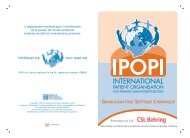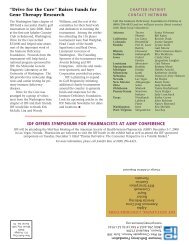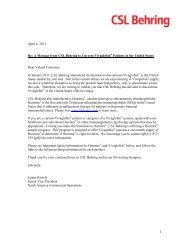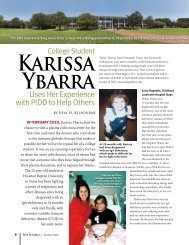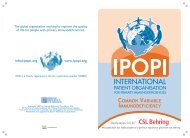IDF Patient & Family Handbook for Primary Immunodeficiency ... - IDFA
IDF Patient & Family Handbook for Primary Immunodeficiency ... - IDFA
IDF Patient & Family Handbook for Primary Immunodeficiency ... - IDFA
You also want an ePaper? Increase the reach of your titles
YUMPU automatically turns print PDFs into web optimized ePapers that Google loves.
Ataxia Telangiectasia<br />
57<br />
General Treatment <strong>for</strong> Ataxia Telangiectasia continued<br />
Special attention should be paid to the lungs.<br />
A-T patients have difficulty taking deep breaths<br />
and coughing to clear mucus from the airways.<br />
They may benefit from daily chest physiotherapy<br />
or use of a therapy vest. If chronic lung disease<br />
develops, a lung specialist should be consulted<br />
about the use of intermittent antibiotic prophylaxis,<br />
inhaled medicines to decrease airway inflammation<br />
or constriction and the need <strong>for</strong> supplemental<br />
oxygen while sleeping. Many A-T patients develop<br />
problems with chewing and swallowing. Those<br />
who aspirate (have food and liquids entering their<br />
windpipe and lungs) may improve when thin liquids<br />
are eliminated from their diet. In some individuals,<br />
a tube from the stomach to the outside of the<br />
abdomen (gastrostomy tube) may be necessary to<br />
eliminate the need <strong>for</strong> swallowing large volumes of<br />
liquids and to decrease the risk of aspiration.<br />
Diagnostic X-rays should be limited because of<br />
the theoretical risk that the X-rays may cause<br />
chromosomal damage. In general, X-rays should<br />
only be done if the result will influence therapy and<br />
there is no other way to obtain the in<strong>for</strong>mation that<br />
the X-ray will provide.<br />
Specific Therapy <strong>for</strong> Ataxia Telangiectasia<br />
Specific therapy <strong>for</strong> the neurologic problems<br />
of A-T is not possible at the present time. The<br />
use of thymic transplants, thymic hormones<br />
and bone marrow transplantation has not led to<br />
improvement. Similarly, there is no evidence that<br />
any specific supplemental nutritional therapy is<br />
beneficial. However, now that the gene has been<br />
identified and the gene’s normal function is being<br />
studied, hopefully new and specific therapy may<br />
become available.<br />
Expectations <strong>for</strong> the Ataxia Telangiectasia <strong>Patient</strong><br />
In general, Ataxia Telangiectasia (A-T) follows a<br />
progressive course. It must be stressed that the<br />
course of the disease can be quite variable and<br />
it is difficult to predict the course in any given<br />
individual. Even within families, where the specific<br />
genetic defect is the same, there can be great<br />
variability in the type and severity of different<br />
neurologic problems and immunodeficiency.<br />
The course of the disease in most patients<br />
is characterized by progressive neurologic<br />
deterioration. Many patients are confined to a<br />
wheelchair in their teens. Infections of the lungs<br />
(bronchitis or pneumonia) and sinuses (sinusitis)<br />
are common and may damage the lungs even<br />
if treated promptly. Malignancies or cancers are<br />
also more common in patients with A-T. They can<br />
be treated but require modifications of standard<br />
chemotherapy protocols. For example, A-T patients<br />
should never receive radiation therapy <strong>for</strong> cancer.<br />
It should be emphasized, that although the above<br />
course is the most typical, the course of A-T<br />
varies considerably from patient to patient. Some<br />
patients have been able to attend college and live<br />
independently, and some have lived into the fifth<br />
decade of life.








